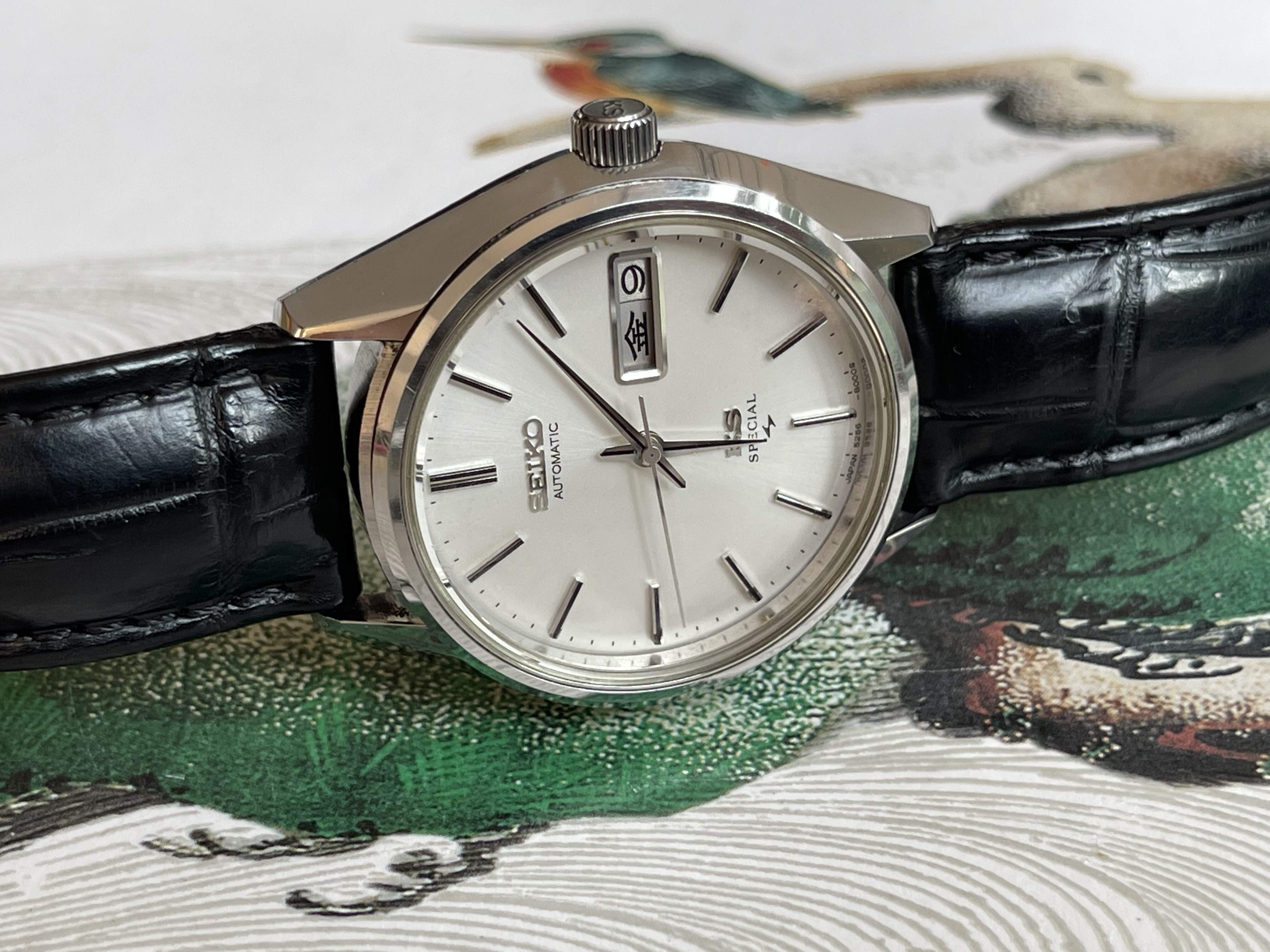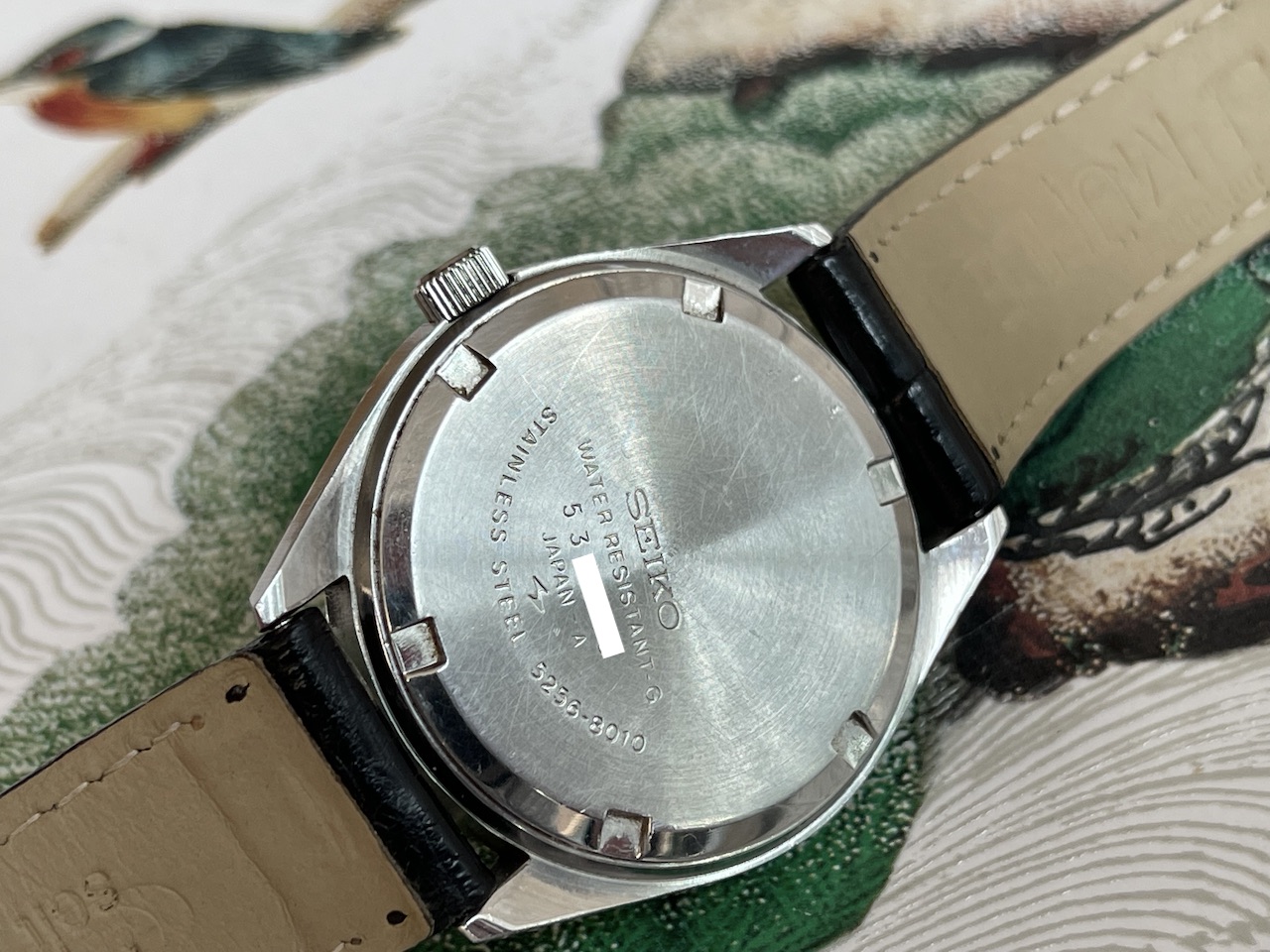
King Seiko 5256-8010 & Hirsch Regent blue croc (Sold)
€ 1010.00
Sold out
| About | Details | and then some |
|---|---|---|
| Manufacture | Seiko | King Seiko |
| Model reference | NBR020 | 5256-8010 |
| Movement | Automatic | |
| Caliber | 5256 | |
| Dial | Silver Sunburst | |
| Case | 38x42x11mm | Steel |
| Lugs | 18mm | |
| Bracelet | Leather (not this strap) | 22cm |
| Crystal serial # | Unknown | Hardlex |
| Timegrapher | Amp 250, Err 0.1 | Accuracy:+1/12spd |
| Jewels | 25 | |
| Serial # | 53xxxx | Production: 1975-03 |
| Condition | Excellent | |
| Service | Not required | |
| Box & Papers | No box | No papers |
This King Seiko 5256 Special Daini edition was manufactured in 1975 only as the last of its kind. The 52KS Special Hi-Beat calibers exist in the "normal" King Seikos but are also common as King Seiko Vanacs. These movements are totally different from the ground up compatred to other KS calibers like the 5626. Its indirect center seconds mechanism for instance is still seen today in more expensive movements from Jaeger LeCoultre, Patek Phillipe and some Piguets. In less expensive movements like the 5626 KS, due to its inherent complexity and cost indirect center seconds was not used. One other important fact is that the 52KS is not prone to quickset damage like the 56KS, which has a plastic cogwheel..
Pricing reflects all this as a Special could cost you close to a 1000 euro at that time. Be that as it may, with their thicker 5256 movement inside these watches were ideally suited to get you to the next level of Seiko's horological achievements, because, let's be clear, that (extended) indirect seconds pinion now ran through a hollow center wheel pinion (!) to carry the seconds hand in the center of the movement where the minute and hour hand already resided.. The inner mechanics to drive that sophistication are in itself another story of brilliant inventions. It is where the 52 leaves the 56 behind.
It is still very apparent, after 42 years of service that a KS can run as new to specifications. Only one other watch surpasses this performance, and it is a Seiko (of course). Some of the models (but not this one) feature an unique external adjusting screw so that the movement can be adjusted without removing the movement from the case. That would be the 5626-7000/7010, "because it needs it" critics might say..
There were essentially five movement options in the King Seiko line:
- 5246A/5246B (1968-1974) - Day/date
- 5256A/5246B (1968-1975) - Day/date
- 5621A/5621B (1969-1974) - Time only
- 5625A/5625B (1968-1975) - Date
- 5626A/5626B (1968-1974) - Day/date
These were produced in "A" (unregulated) and "B" (regulated) grades, with some being "Special" movements moving up to the next standard of accuracy - denoted by the third digit 4 and even 5. All "B" movements were chronometer grade, with many receiving official certification, as noted on the dial.
Some models in the 56KS lineup strongly resembled the Grand Seiko line, especially Daini's legendary Grand Seiko 44GS, which had recently gone out of production. You see, at some time in the sixties Taro Tanaka, Seikos first hired graduate of a College Design Program, came up with design rules which eventually came to be known as the Grammar of Design at Seiko. He wanted Grand Seiko and King Seiko watches to sparkle brilliantly when on display and without any distortions.
The rules were simplicity itself:
1. Perfectly flat surfaces and angles for cases, dials, hands, indexes
2. Two Dimensional faceted curves for the bezel
3. All distortion should be eliminated from the dial, hands, indexes and case, the finishing of the dial and case should be a mirror finish so it shines and sparkles
4. No more round cases, a unique case design
Those looking for the most valuable King Seiko should look for a mid to late sixties Daini or Suwa release like the King Seiko 5626-7000. (Case and dial design sparkling from all angles). In all its aspects Tanakas design is so iconic that all Seiko products that were released afterward emulated it. Those looking for the most valuable Vanac might look to find these design cues implemented.
Seiko produced many 56KS models at first, but it quickly became apparent that high-end watch buyers were more interested in the new quartz watches the company also produced. Sales and production fell dramatically as the 1970's got underway, with the line petering out in 1974 and 1975. But 1976 the King Seiko was no more, with the 56KS cancelled the previous year and the King Seiko 52KS being the last model in production.
The later and now much rarer versions of the KS were in the Vanac line, the funky mod line of the early 1970’s. There is no official explanation as to why they are called Vanac. As one can see, Vanacs are quality watches with a lot of effort put into the bracelets. Other details such as cases, hands and dials are really 70s GS quality. The size is normal 70s at 36-38mm, but most do not wear small due to the chunky cases. The Vanac is not uncommon, but can be very hard to find in good condition. The facetted crystals are often damaged and it can be hard to find replacements for them.
Of course much of what has been said about automatic King Seikos could also be said about automatic Grand Seikos and even some of the Lordmatic (LM) models of the same period. The LM range also used both the 56xx and 52xx movement streams (although lower grade versions, and in the case of the 5606 lower beat), while many Grand Seikos of the period used the 56xx stream. Although the GS 56xx movements were numbered 564x rather than 562x indicating a higher quality and/or level of adjustment, the accuracy it is possible to achieve from 562x KS movements suggests to me that if serviced and adjusted, they are effectively equal to the GS 564x ones. So in this sense, vintage automatic King Seikos may practically be the equivalents of Grand Seikos, but offer better value for money because of the ongoing status of the Grand Seiko label - whereas the KS label is now purely historical.






